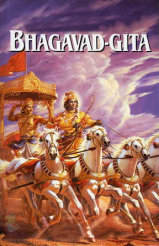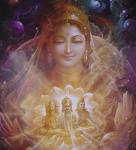Search results for Sruti (9)
VEDA, SMRITI, SRUTI
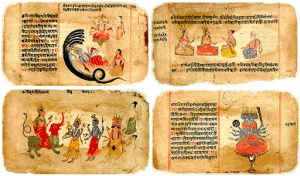
> YOGA & LIVE SANSKRIT CLASSES <
Śruti (Sanskrit: śrúti, „hearing, listening“) is a term that describes the sacred texts comprising the central canon of Hinduism and is one of the three main sources of dharma and therefore is also influential within Hindu Law. These sacred works span the entire history of Hinduism, beginning with some of the earliest known Hindu texts and ending in the early modern period with the later Upanishads.. Śruti is often cited as akin to the Vedas; however, it also contains various supplementary commentaries on them. This literature differs from other sources of Hindu Law, particularly smṛti or “remembered text”, because of the purely divine origin of śruti. This belief of divinity is particularly prominent within the Mimamsa tradition. The initial literature is traditionally believed to be a direct revelation of the “cosmic sound of truth” heard by ancient Rishis who then translated what was heard into something understandable by humans.
Smṛti (Sanskrit: स्मृति), literally „that which is remembered,“ refers to a specific body of Hindu religious scripture. Smṛti also denotes non-Shruti texts and is generally seen as secondary in authority to Shruti. The literature which comprises the Smriti was composed after the Vedas around 500 BCE. Smriti also denotes tradition in the sense that it portrays the traditions of the rules on dharma, especially those of lawful virtuous persons. This is understood by looking at traditional texts, such as the Ramayana, in which the traditions of the main characters portray a strict adherence to or observance of dharma.

Themenabende im Monat Mai / Juni mit Shri Sarvabhavana
Wir laden herzlich ein zu den Vorträgen und Veranstaltungen mit Shri Sarvabhavana im Monat Mai/ Juni VORTRÄGE in BERLIN / DRESDEN & PIRNA
The Bhagavad Gita (pronounced: [ˈbʱəɡəʋəd̪ ɡiːˈt̪aː] (![]() listen)), also referred to as Gita, is a 700-verse Hindu scripture that is part of the ancient Sanskrit epic Mahabharata. Due to its presence in the epic, it is classified as a Smṛiti text. However, those branches of Hinduism that give it the status of an Upanishad also consider it a Śruti or „revealed text“.[1][2] As it is taken to represent a summary of the Upanishadic teachings, it is also called „the Upanishad of the Upanishads.“[3] HERE
listen)), also referred to as Gita, is a 700-verse Hindu scripture that is part of the ancient Sanskrit epic Mahabharata. Due to its presence in the epic, it is classified as a Smṛiti text. However, those branches of Hinduism that give it the status of an Upanishad also consider it a Śruti or „revealed text“.[1][2] As it is taken to represent a summary of the Upanishadic teachings, it is also called „the Upanishad of the Upanishads.“[3] HERE
Free Will…now in english! http://www.vedic-guide.de/en/texte/freier-wille
http://www.facebook.com/shrisarvabhavana
RAM NAWAMI IN ‘INDIA’, Prof. Chitralekha Singh
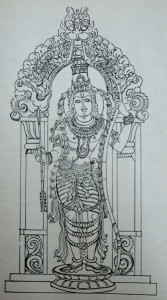
Rama (IAST: rÄ�ma, DevanÄ�garÄ�: राम; Lao: ພຣະຣາມ; Malay: Megat Seri Rama; Tagalog: Rajah Bantugan; Thai: พระราม) or Ramachandra रामचंद्र is the seventh avatar of Vishnu in Hinduism,and a legendary king of Ayodhya in ancient Indian mythology.
Rama is one of the many popular figures and deities in Hinduism, specifically Vaishnavism and Vaishnava religious scriptures in South and Southeast Asia.Most of the details of Rama’s life come from the Ramayana, one of the two great epics of India. Born as the eldest son of Kausalya and Dasharatha, king of Ayodhya, Rama is referred to within Hinduism as Maryada Purushottama, literally the Perfect Man or Lord of Self-Control or Lord of Virtue. Rama is the husband of Sita, whom Hindus consider to be an avatar of Lakshmi and the embodiment of perfect womanhood. Read More: > HERE <
Rama Navami (DevanÄ�garÄ�: राम नवमी) also known as Sri Rama Navami is a Hindu festival, celebrating the birth of Lord Rama to King Dasharatha and Queen Kausalya of Ayodhya. Rama is the 7th incarnation of the Dashavatara of Vishnu. The festival falls in the Shukla Paksha on the Navami, ninth day of the Chaitra month of Hindu calendar. Thus it is also known as Chaitra Masa Suklapaksha Navami, and marks the end of nine-day Chaitra-Navratri celebrations.
In the epic Ramayana, Dasharatha, the Emperor from Ayodhya, had three wives named Kausalya, Sumitra and Kaikeyi in the Treta Yuga, which follows the Satya Yuga and is succeeded by Dwapara Yuga. Their greatest worry was that they had no children, and so they had no heir to the throne in the Ikshvaku Kula or royal lineage of great, pious, wonderful Emperors. Rishi Vasistha suggests him to perform Puthra Kamesti Yagna, through which he can have a desired child.
Among the incarnations of the Supreme Being, that of Rama & Krishna are considered very significant for humanity as it was possible for human beings to relate to him in person. In the Ramavatar (Incarnation of Ram) hsis auspicious qualities were manifest and he set an example to mankind by his adherence to Dharma (Religion). Rama’s matchless prowess as a warrior and his valorus deeds have lent the name ‘Mahavira Vaibhav’. Kalyan Guna (Welfare to humanity) is the main evident of Lord Rama.
It was his Kalyan Guna that he condoned the faults in others even when they had caused harm to him. The most important instance was when Ravana stood helpless without arms in the battlefield it would have been very easy to finish him off if the feeling of revenge on the one who had abducted his wife and kept her under captivity had over ridden, his sence of Dharma in warfare. His propriety and his inborn trait of pardoning others faults came to the tore in this critical juncture. The other Quality which was singular in Rama was his easy accessibility to everyone because of his innate affability (Sausilya). He was not only the supreme being incarnate but also the prince-regent, heir to the emperor of the mighty kingdom of Ayodhya.
Rama endeared himself to one and all by his noble qualities during his exile in the forest, the manner in which Rama addressed Guha, touched by his service by declaring that he was indeed his brother. These are few examples of his holy and piousness.
In Ramayan 16 outstanding qualities of Lord Rama is referred as ‘Krishna’ he performed the very delecate task of proceedings as an envoy of the Pandava’s to explore whether peace could be ensured. In several ways he saved the Pandava’s.
Rama was a prince and as such he could not be assigned the job of an ambassador, however there was an occasion when he admired such a task by another and he felt sorry. He was denied a similar privilege and so in his next manifestation he himself volunteered to do this service. All Gods incarnation are identical in bringing out his concern for those who place their faith in him. Lord descended on the earth protect the pious and thereby revealed his easy accessibility the destruction of wicked men was also his concern but this could have been accomplished by his will.
‘Thyagraja’ the great writter has emphasised that Sri Rama is unique. He said that Rama is ‘Parabrahama’ he is his ‘Ishtadevta’ – He has written many songs in the praise of Lord Rama in ‘Harikambhojit Kirtana’ – He said “Rama is the one and only God. Oh Mind! why do you dissipate?” ‘He is Brahma, Siva, Indra, permanent and the antar yamin in all beings.’
„Hey Ram – Hey Ram“, is a great Devotional prayer sung in the praise of Hindus God Rama. A beautiful bhajan by Jagjit Singh. http://gita-blog.blogspot.com/
Rama is the character who is delighted and grateful even by one act of help by anyone and never entertains in his mind any hostility to one who has done him enormous harm.
Balmiki’s Ramayana is revered as the essence of the vedas itself and ‘Rama’ portrayed as the very passonification of dharma. The purpose of studying scriptured texts like ‘Ramayana’ is to the divine level. One can make his life sublime by a word of comfort to help another in distress. The script of Ramayana desist one from turning proud, when by divines grace one is placed is a high position or is intellectually superior. Ramayana is an epic of Moral values of human being, great source of in spiration to the whole of humanity. India as Ramayana’s birth place is well known and Ramayana has been part and parcel of the Indian way of life from time immemoriel.
Tulsidas has also witten’ Ram Charit Manas’ the history and the great story of ‘Rama’ as an epic which is very popular as it is described in a very simple manner to apporach to the heart of human being-.
Ramnawami is a great day when Rama was born in the Kingdom of Ayodhya King Dashratha & Kaushalya. Today her all incarnation a Shailputri, Brahmacharini, Chaudraghante, Kushmanda, Skandhamata, Katyayni, Kalratri, Mahagauri, Siddhidarti and on the last day on Nawami this year on 23rd March everybody celebrates the birthday of Sri Ram in all its gay mood wearing new clothes, meeting & greeting each other worshipping their Ishta Dev/Devi and congratulates each other.
Article by Prof. Chitralekha Singh
Dean: Institute of Visual, Performing Arts & Research, Mangalayatan University, Beswan, Aligarh.
Visit at: www.artistchitralekha.com
e-mail: chitralekha@artlover.com mob . 91 9319103482
- Ramayana or Ramkatha, NEWS on Festival of Ramkatha <
- Ramayana, Valmiki Ramayana, Adhyatma Ramayana, Tulasi Ramayana- Yogavasistha <
- VEDA, SMRITI, SRUTI on Dharma <
- MORARI BAPU – THE RAMAYANA EPIC POEM <
- Articles „DHARMA“ <
- http://en.wikipedia.org/wiki/Dharma –
- www.ramayoga.net
- Meet Morari Bapu, friends, studies, fans at fb <
- Meet Hinduism, studies, friends, fans at fb <
- According to the various Indian religions, such as Hinduism, Buddhism, Jainism, and Sikhism, beings that live in accordance with Dharma proceed more quickly toward dharma yukam, moksha or nirvana (personal liberation). The antonym of dharma is adharma meaning unnatural or immoral.
Researches in Indian and Buddhist Philosphy
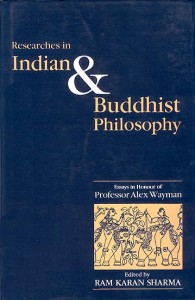
> Chap16: Comp. Siddis in Bhagavata Purana & Patanjali Yoga Sutras <
> BOOK: SIDDHIS IN THE BHAGAVAD PURANA <
Siddhi (Devnagari सिद्धि) is a Sanskrit noun that can be translated as „perfection“, „accomplishment“, „attainment“, or „success“. The term is first attested in the Mahabharata. In the Pancatantra, a siddhi may be any unusual skill or faculty or capability. As a legal term in the Manusmriti, it refers to the settlement of a debt.
In the Samkhya Karika and Tattva Samasa, and hence in Tantric Buddhism, it specifically refers to the acquisition of supernatural powers by magical means or the supposed faculty so acquired. These powers include items such as clairvoyance, levitation, to be present at various different places simultaneously, to become as small as an atom, to materialize objects, to have access to memories from past lives, etc. The term is also used in this sense in the Sarvadarsana-samgraha of Madhvacharya. Read More: > HERE <
Researches in Indian and Buddhist philosophy:
Essays in honour of Professor Alex Wayman, RÄ�ma Karaṇa ŚarmÄ�
The present volume, comprising ninteen articles by renowned scholars, is divided into three sections, namely, Buddhist Jaina and Hindu Philsosphical Researches. The articles in Hindu section take a comperative base. K.K.Raj compares the Buddhist and Mimamsa views on Laksana. K. Bhattacharya speaks of grammarians and philososphers regarding post-Panini grammarians on a certain anusasana. R.C.Dwivedi compares kashmir Saivism with Sankara`s Vedanta and T.S.Rukmani compares Siddhis as found in the Bhagavata Purana and in Patanjali`s Yogasutras. R.V. Joshi compares the Advaita and the Vaisnava views of the matter.
The present volume, comprising nineteen articles by renowned scholars, is divided into three sections, namely, Buddhist, Jaina and Hindu Philosophical Researches.
Under the Buddhist section Bareau, using the Vinaya in Chinese, defends Wayman’s position that Asanga belonged to Mahisasaka sect. Nakamura points out differing view about the seven Vajjian Republic principles. Michael Hahn and Samtani concern with Buddhist poet Candragomin and the term raga resectively. Shinjo Kawasaki expounds the views of Bhavya about the differing karma of non-sentient and sentient beings. Hirakawa’s article deals with the relation with dhatu. Collett Cox shows that the present 12-membered formula is taken for granted by early Chinese Abhidharma texts.
In Jaina section, Jaini deals with the theory that an omniscient being can subsist on a subtle kind of food. Dhaky’s main object t ascertain early parts of Dasavaikalikasutra, also goes into the matter of food.
The articles in Hindu section take a comparative base, K.K. Raja compares the Buddhist and Mimamsa views on Laksana. K. Bhattacharya speaks of grammarians and philosophers regarding post-Panini grammarians on a certain anusasana. R.C. Dwivedi compares Kashmir Saivism with Sankara’s Vedanta and T.S. Rukmani compares siddhis as found in the Bhagavata Purana and in Patanjali’s Yogasutras. R.V. Joshi compares the Advaita and the Vaisnava views of the matter.
The work breaks new grounds and is a solid contribution in the field of Indian Philosophy.
About the Author – Prof. R.K. Sharma as a Fulbright Scholar, worked with Prof. M.B. Emeneau at University of California. He has all along been contributing to promotion of Sanskrit Studies in India and abroad as Founder Director, Rashtriya Sanskrit Sansthan, Joint Educational Adviser, Govt. of India, Vice-Chancellor of the two Sanskrit Universities at Darbhanga and Varanasi, Visiting Professor at Columbia University of New York City, University of Bihar and Chicago, Organizing Secretary of two world Sanskrit Conferences, etc. He is a recipient of Presidential Award of Honour in Sanskrit and a Fellow of the Royal Asiatic Society.
Yogis in Tibet
Instructions On Siddhis
1. By the process of Hatha Yoga, the Yogi attains perfect physical body—Rupalavanya Bala Vajrasam-hanana Kaya Sampat. “The perfection of the body consists in beauty, grace, strength and adamantine hardness.” The power to bear extreme cold and heat (Titiksha), the power to live without water and food and other powers come under the category of Kaya Sampat (perfection of body).
2. Since the body of the Hatha Yogi is perfect and firm, his mind also is firm and one-pointed. By the practices of Dharana and Dhyana, he reaches the highest rung in the Yogic ladder and attains Immortality through Yogic Samadhi. The Yogi who has reached the highest stage, will have the 8 major and all the minor Siddhis.
3. Attainment of powers depends upon the amount of concentration at different Chakras and Tattvas and awakening of Kundalini. The practice of Mudras, Bandhas, Asanas and Pranayamas will also help a lot in acquiring Siddhis.
4. The Siddhis that are obtained by the practice of Mudras can be obtained by the practice of Bandhas, Asanas, Pranayamas and also by the concentration on different Chakras. That depends upon the temperament and capacity of the aspirants. One can obtain the desired goal by one exercise and others by different methods. Therefore if one is not able to get success by a particular exercise, he will have to have recourse to other exercises.
5. Many of the 8 major Siddhis are not possible at all at the present age (Kali Yuga), when the body and mind of the vast majority are not fit enough. Even today there are several Siddhas who have the power to perform some of the Siddhis. When people approach them to do this and that, they hide themselves or generally say:—“I do not know.” They are not much particular about these Siddhis. Their aim is to ignore these as unreal and aspire to reach the highest. They are the only real Yogins. Many are able to use some powers and they do not know how they are able to do them.
6. One can read the thoughts of others. A man in London hears the spiritual message of sages in India. You have seen several persons removing the poison of cobras by chanting some Mantras or by mere touch. By giving some sort of leaves, incurable diseases are cured. There are men who will very accurately tell your past, present and future. Some are able to see astral entities. Stopping the functions of the heart and changing the mind of others and other powers are due to Yogic practices.
7. Nowadays you cannot find a man who has developed all the powers. When one gets certain powers, he stops there by the influence of Maya and false Tushti (satisfaction) and uses the powers for his livelihood or for fame. Therefore he is not able to proceed further and attain perfection. It is not the mistake of the Yogic Kriyas. You should not lose faith. Faith, attention, sincerity and earnestness will lead you to success.
“ Of one thing we can be certain. The real Siddha who does not want or care for Siddhis, but who manifests Siddhis for unselfish reasons and as a result of communion with the Lord or the Brahman, is an entirely different person from the little man who has psychic powers to do things which are extraordinary or who has control of spirits. The power over spirits (good or bad) is entirely different from spiritual power. And no real Siddha goes about calling himself a Bhagavan or parading his powers. It cannot be said that the Siddha does not know that he performs miracles but they are not miracles to him—they are just ordinary things for him because he lives in the plane beyond the reach of the common man. I have to conclude that Swami Sivananda is one such. But he does not reveal himself as such to all and sundry.“ – Sri Swami Sivananda
- Also read from Kundalini Yoga- SRI SWAMI SIVANANDA
- KUNDALINI
- INTRODUCTION
- YOGA SADHANA
- PRANAYAMA
- PRAYER TO MOTHER KUNDALINI
- EXPERIENCES ON AWAKENING OF KUNDALINI
- GRADATIONAL ASCENT OF MIND
- PRANAYAMA FOR AWAKENING KUNDALINI
- ASANAS
- MUDRAS AND BANDHAS
- EIGHT MAJOR SIDDHIS
- DHARANA
- YOGA-KUNDALINI UPANISHAD
- Tibetan schools of Yoga:
- Anuyoga
- Mahayoga
- Six Yogas of Naropa
- Trul khor (Yantra Yoga)
UNESCO – The Tradition of Vedic Chanting
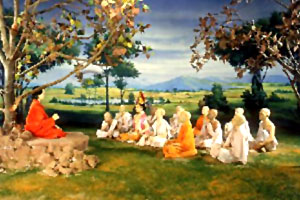
Shiksha is one of the six Vedangas
> UNESCO PUBLISHING, PURANAS & YOGA <
A shakha (Sanskrit śÄ�khÄ�, „branch“ or „limb“), is a Hindu theological school that specializes in learning certain Vedic texts, or else the traditional texts followed by such a school. An individual follower of a particular school or recension is called a śÄ�khin.- the term is also used in Hindu philosophy to refer to an adherent of a particular orthodox system.
A related term caraṇa, („conduct of life“ or „behavior“) is also used to refer to such a Vedic school : „although the words caraṇa and śÄ�khÄ� are sometimes used synonymously, yet caraṇa properly applies to the sect or collection of persons united in one school, and śÄ�khÄ� to the traditional text followed, as in the phrase śÄ�khÄ�m adhite, („he recites a particular version of the Veda“)“. The schools have different points of view, described as „difference of (Vedic) school“ (śÄ�khÄ�bhedaḥ). Each school would learn a specific Vedic Saṃhita (one of the „four Vedas“ properly so-called), as well as its associated Brahmana, Aranyakas, Shrautasutras, Grhyasutras and Upanishads. Read More: > HERE <
The Vedas comprise a vast corpus of Sanskrit poetry, philosophical dialogue, myth, and ritual incantations developed and composed by Aryans over 3,500 years ago. Regarded by Hindus as the primary source of knowledge and the sacred foundation of their religion, the Vedas embody one of the worlds oldest surviving cultural traditions.
The Vedic heritage embraces a multitude of texts and interpretations collected in four Vedas, commonly referred to as books of knowledge even though they have been transmitted orally. The Rig Veda is an anthology of sacred hymns; the Sama Veda features musical arrangements of hymns from the Rig Veda and other sources; the Yajur Veda abounds in prayers and sacrificial formulae used by priests; and the Atharna Veda includes incantations and spells. The Vedas also offer insight into the history of Hinduism and the early development of several artistic, scientific and philosophical concepts, such as the concept of zero.
Expressed in the Vedic language, which is derived from classical Sanskrit, the verses of the Vedas were traditionally chanted during sacred rituals and recited daily in Vedic communities. The value of this tradition lies not only in the rich content of its oral literature but also in the ingenious techniques employed by the Brahmin priests in preserving the texts intact over thousands of years. To ensure that the sound of each word remains unaltered, practitioners are taught from childhood complex recitation techniques that are based on tonal accents, a unique manner of pronouncing each letter and specific speech combinations.
Although the Vedas continue to play an important role in contemporary Indian life, only thirteen of the over one thousand Vedic recitation branches have survived. Moreover, four noted schools in Maharashtra (central India), Kerala and Karnataka (southern India) and Orissa (eastern India) are considered under imminent threat.
The Vedic literature that has come down to our times is attached to various traditional schools of recitation and ritual called the ‘shakhas’. All the four Vedas have more than one shakha extant. In the past, the number of shakhas studied was many times more.
According to the Mahabhasya of Patanjali, there were 21 shakhas of Rigveda, 9 of Atharvaveda, 101 of Yajurveda (86 of Krishna Yajurveda and 15 of Shukla Yajurveda, according to later authorities) and a 1000 varieties of chanting of Samaveda. Maybe, the number 1000 for the Samaveda merely refers to ‘numerous’. Nevertheless, although only 20 or so Shakhas of the Vedas are extant now, we do possess names of most of the lost Shakhas of the Rigveda, Yajurveda and Atharvaveda. Fragments of many of the lost shakhas are also available as quotations in ancient works. For the Samaveda, we do not have more than 40 names extant.
Two different Vedic shakhas might share one or more texts amongst themselves. Conversely, the distinction between two shakhas of the same Veda might result from the use of a different Samhita text, and/or a different Brahmana text, and/or different Kalpasutra text and so on. For e.g., the Baudhayana and the Apastamba shakhas use the same Taittiriya Brahmana, Taittiriya Samhita and Taittiriya Aranyaka but follow different Kalpasutras. On the other hand, the Shankhayana and the Kaushitaka shakhas use the same Samhita and Shrauta Sutra but their brahmanas have slightly different readings and their Grhyasutras are quite different.
A group or a community of people who study a particular shakha in its entirety (Samhita + Brahmana + Aranyaka + Kalpasutra + any additional texts) and perform its ritual constitute a ‘charana’. For instance, Brahmins who study the Taittiriya Samhita/Brahmana/Aranyaka together with the Kalpasutra of Apastamba say – “I follow the Apastamba charana’.
In certain cases, we have instances of ‘mixed shakhas’. For instance, the followers of Shakala shakha have adopted the Kalpasutra of Ashvalayana. The Ashvalayana shakha, which had the now well-known Ashvalayana Sutra, has in turn lost oral traditions of its Samhita. Likewise, the Kaushitakins of Kerala often use the Samhita of Shakalas.
The various shakhas of the Vedas were, at one time, spread throughout South Asia. Their geographical location has not been constant down the ages, as communities of Brahmins professing a particular shakha migrated from one part of India to the other, or adopted another shakha when it became impossible for them to sustain the tradition of their own shakhas.
It is quite certain however, that the tradition of recitation of the Vedic texts originated in north India, and this region was the area where almost all the shakhas originally arose. From various sources, we can determine the following geographical distribution of Vedic Shakhas at various intervals of times, and their present state of survival:
VEDA, TREE´s AND THE HOLY SCRIPTURES
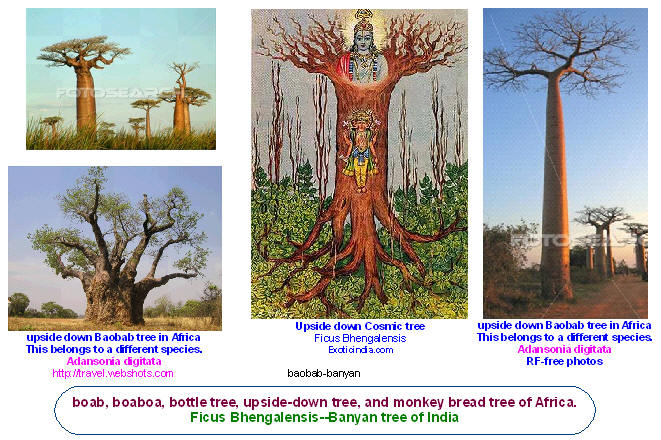
> Sanskrit Web / Yayurveda, Taithreeya Aryanka <
> BIHAR SCHOOL OF YOGA, SRI SIVANANDA MATH <
The Aranyakas/Wald Texte der Veden, (Sanskrit आरण्यक Ä�raṇyaka) are part of the Hindu śruti, the four Vedas; these religious texts were composed in Late Vedic Sanskrit typical of the Brahmanas and early Upanishads; indeed, they frequently form part of either the Brahmanas or the Upanishads. „Aranyaka“ (Ä�raṇyaka) means „belonging to the wilderness“ (araṇya), that is, as Taitt.Ar.2 says, „from where one cannot see the roofs of the settlement“. They contain Brahmana-style discussion of especially dangerous rituals such as the Mahavrata and Pravargya, and therefore had to be learned in the wilderness. They have also served as receptacles of later additions to the Vedic corpus. However, they have nothing to do, as later tradition has it, with Sannyasins or Vanaprasthas and they are not of „mystical“ nature but very close to the Brahmanas proper. Read More: > HERE <
The Taittiriya Upanishad is one of the older, „primary“ Upanishads commented upon by SHANKARA. It is associated with the Taittiriya school of the Yajurveda. It figures as number 7 in the Muktika canon of 108 Upanishads. It belongs to the Taittiriya recension of the Yajurveda and is constituted by the seventh, eighth and ninth chapters of Taittiriya Aranyaka.
The tenth chapter of the same Aranyaka is the Mahanarayana Upanishad. The Taittiriya Upanishad describes the various degrees of HAPPINESS enjoyed by the different beings in creation. Read More: > HERE <
Real Identity of Asvattham tree. It is called “Arasa Maram”
There is some confusion in books about the identity of Asvattham tree. It is called “Arasa Maram” (Ficus religiosa) in Tamil Nadu, Ravi-manu in Telugu, Aruli-mara in Canarese. One calls it a Palm tree; another calls it Pipal (Ficus religiosa-pagoda fig-tree); and yet another calls it Banyan Tree (Ficus Bhengalensis) with the adventitious aerial roots. Both (the latter two) are related to each other. It is a humongous tree with bright green leaves chatting with each other with a pat on the back as they rustle in the gush of wind. It is music to the ears. The breeze sets the leaves dancing in the wind and doing partial pirouette on their spindly petioles. When the wind quiets down, the song and dance stop suddenly.
One thing we know is that it is a cosmic tree. The berry of the Pipal is sweet, and Soma (intoxicant) is prepared from its juice according to some accounts. (There is another claim that says the soma juice comes from a mushroom.) Images of Pipal tree appear on the Harrapan seals. Asvattham is said to be a “body-tree.” “A” is no; “THA” is existence; “Shva” means “after tomorrow:” No existence after tomorrow. It tells us that life is precarious. The body tree itself is imperishable (HAM), because God pervades it.
The tree is rooted in heaven and since its aerial adventitious roots go down to anchor to the earth and Prakrti (matter), we are susceptible to the temptations of evil. The middle branches are the men and the sap that keeps flowing inside and sustaining the branches are the Gunas (modes). Cutting the branches and the aerial roots figuratively depicts transcending the gunas and a move to a higher plane― that of SannyÄ�si.
In Chinese lore, the body is compared to the Bodhi tree (Tree of Wisdom). Katha Upanishad 2.3.1: With the root above and branches below the fig tree stands: That is pure, That is Brahman, That is immortal. In It the world rests and no one goes beyond it. The upside down Tree of Life has roots in Brahman: The tree, the roots, the trunk, and the branches represent Manifest Brahman or the phenomenal world of Isvara, matter and beings.
Katha Upanishad describes Manifest Brahman as follows: He is self-born and first-born from the waters (Mula Prakrti, root cause or matter) by an act of meditation. He resides in the cave of the heart of beings and is immanent in all causes and effects. He who knows this knows the Absolute in Him. Verse 2.1.6
It goes on to describe the Mother Goddess. She is Aditi, the Boundless. She is born as Prana (Breath or life) from the Absolute genderless Brahman, the nameless, and the formless. She is the Devatamayi (Mother of gods) and the soul of all beings. She stands in the inner recess of the heart. Verse 2.1.7
The Buddha attained enlightenment under the Bo tree; Bo is short for bo-gaha, tree of wisdom; Bo tree is Pipal or Banyan tree; Bo is wisdom, Bodhi is enlightenment, Buddhi is knowledge and the Buddha is he who attained enlightenment. Bodhisattva is potential Buddha meaning that the aspirant has wisdom (enlightenment) and virtue (Bodhi + Sattva).
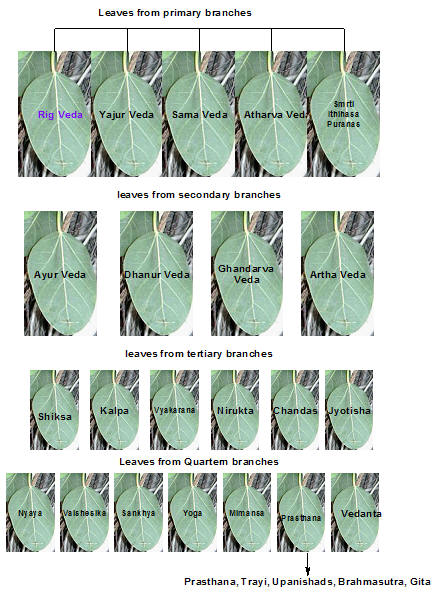
Krishna states that He is Asvattha tree among trees. Jesus Christ says that he is the true vine. It appears the trees have souls from what Lord Krishna and Jesus Christ say. Why are we cutting them indiscriminately and depleting our forests?
Sage Narada cursed the two sons of Kubera to become trees for knowingly playing naked in the shoal of a river with Ghandarva women. (You thought that having a shower mate is a modern phenomenon: not so from what you read here.) The young women in a turn of modesty put on their clothes while the Kubera’s sons ignored the sage, who cursed them to become trees for their feral nature, arrogance, insolence, and ignorance; Krishna released their souls and bodies after one hundred divine years by uprooting the trees.
Krishna drank water from River Sarasvati, sat, and meditated under Asvattha (Pipal) tree in a reclining position, before his departure to Goloka, Bhagavata Purana 3.4.3 and 8. River Sarasvati went dry before 1900 B.C. At present Sarasvati River features as a pentimento from satellite earth images.
Mantra Pushpam – Vedic Hymns
This mantra is from Taithreeya Aranyakam of Yajur Veda
Asva, meaning horse, is the root word for Asvattha, the tree; Asvamedha, horse sacrifice; Asvatthaman, he who cried like a horse at birth; Asvatthaman, the elephant; Asvini, the wife of Asvins, who took the form of a mare; and Asvinikumaras, the sons of Asvini-the sons of a mare. Asvattha tree gained such name because people used the tree’s shade as shelter for horses. Professor Bokonyi of Hungary an expert in the anatomy of horses tells that the true horses were present in Kutch area during the late Harappan period. The Aryans migrated from India in several waves to Iran to Caucasus riding on the horses as early as 4000 B.C. Rg Vedic civilization was before 5000 B.C. Indo-European languages have loan words like Aspa, Aihva, aszva, aspa, asa, iss, issi, issia, assa, sisu, equus. Where did they originate from? Yes, from Sanskrit. Let us look at another view. Domestication of horse: the credit goes to Akkadians; that is one view. The majority opinion is that the Indo-Aryan was the first domesticator of the horses. They wrote the first manuals for horse training.
Between 2000 B.C. and 1700 B.C. the Aryans (the late comers) in Babylon domesticated the horses which were then called the ass of the East. The horse was later introduced in Egypt before 1580 B.C. The Aryan victory march was attributed to tamed fast horses and chariots.
Sri Swami Satyananda Saraswati calls this tree The Mystical Tree. He says that this imperishable tree has roots above and branches below. The human body, according to him, resembles the upside-down tree in that the brain forms the root structure; the spinal column, the tree trunk; and the leaves, the thoughts, emotions and distractions. The occult truth and the secret knowledge of the Mystical Tree cannot be understood until the aspirant gets spiritual awakening.
Let me touch upon the significance of tree in Christianity. As you see Krishna’s image on the cosmic tree, it reminds us of Jesus Christ on Holy Rood, the tree of immortal life, and he is himself the fruit of the tree. Jesus on the cross, the Buddha under the tree, and Krishna on the cosmic tree–my interpolation, are the same figures. Page 107 The Power of Myth, by Joseph Campbell. Joseph Campbell, the universal man, sees oneness in Jesus Christ and the Buddha. Campbell is one among the rarest of breeds who knows the essence of (a generic) religion. He can see through the apparent differences among the religions and find the common Truth.
15.2: Its branches extend downwards and upwards nourished by Gunas, with sense objects as shoots or sprouts; and its roots extend downwards to the world of men, bound to karma.
The tree has many adventitious roots, coming down from the tree branches; the wider the tree grows the more adventitious roots there are. These adventitious roots, compared to ego, ignorance and vasanas supporting the heavy branches grow down, while the cosmic roots of the tree trunk grow towards heaven and anchor in Brahman. The lower branches are synonymous with human beings, animals, birds, reptiles, worms, insects, and insentient and immovable matter. The upper branches are comparable to Ghandarvas, yaksas, gods, and goddesses.
The sap of Gunas nourishes the branches, the product of Prakrti; the sap flowing through the upper branches contains Sattva (goodness and virtue), while that of the lower branches comparable to animals, contains Tamas (ignorance and delusion). The middle branches are the men with varying combinations of the Gunas and thrive by the sap of Sattva, Rajas, and Tamas in varying combinations. The adventitious roots of the middle and lower branches represent bondage of the human beings and animals. The lateral branches are the sense objects, namely sound, vision, smell, taste, and touch; the growing ends of lateral branches are the ears, eyes, nose, mouth, and skin; the leaves representing the Vedas reach for the sun and illumination from God.
The adventitious roots originate from branches, which draw nourishment from Gunas: they are extensions of these branches and therefore of the gunas, which are responsible for the way men behave. The adventitious roots or the gunas anchor to Prakrti and bind the jivatma to karma and therefore to Sams�ra. In this world of beings, man has the most opportunity to advance to a higher state, fall to lower state, or remain in the same state. The animals are born in the lower state because they have to resolve the pr�rabda (past) karma inherited from the past life; they do not accumulate new karma in the present life because their acts are commensurate with their animal traits; and they are incapable of making informed choice from Sattva, Rajas, or Tamas. But, man on the other hand can accumulate new karma because he can choose his (thought), word, and deed.
Krishna in his discourse in The Uddhava Gita, Dialogue 7.21-7.24 describes the Tree of Life. (based on translation by Swami Saraswati.)
The tree of Samsara bears flowers and fruits; good and bad deeds are its seeds; desires are its deep roots; Sattva, Rajas, and Tamas are its support; earth, water, fire, air, and ether are its five secondary branches through which five kinds of sap (smell, taste, sight, touch and hearing) flow. The five branches fork into ten branches: five motor organs, five sensory organs plus the mind. Two birds (The Supreme One and Ahamkara) live in their nests in the branches. The bark has three layers, the three humors of the body: wind, bile and phlegm. The tree bears two fruits: joy and sorrow. Some eat the fruit of sorrow; some on right path eat the fruit of joy. Krishna tells Uddhava to cut down the tree and free the Self, identifying himself with the Self.
15.3: Neither its form nor its end nor its beginning nor its support is seen. Having cut this firm-rooted Asvattham tree by the strong weapon of detachment…
15.4: Thereafter, seek out that goal, attaining which one does not return again. Surrender to the (first and) Primal Person from whom the ancient manifestation comes forth.
We have to cut the adventitious roots to prevent lowermost branches from getting the sap of Tamas (darkness and delusion); then we have to cut the adventitious roots, which supply the Rajas sap (motion and passion) to the middle branches; now we are left with the upper branches (and their adventitious roots), whose sap is Sattva (goodness, virtue, and calmness). To attain to Brahman, we have to transcend all three Gunas and therefore have to cut the tree, roots, and all. The tree represents the nonself or Prakrti, and we have to separate the Jiv�tman from Prakrti, so it merges with the Higher Self.
Let me explain what attaining to Brahman means. It points to a certain quality of life and behavior. It is simply not having the didactic knowledge of the Holy Scriptures; it is not simply the rituals alone. Dharma, duty; sama, equanimity; dama, self-control; vairÄ�gya, indifference to worldly objects; uparati, desisting from sensual enjoyment; sraddhÄ�, faithfulness; and atha, “much more or more over,” (auspiciousness, authority, flair and divine grace) are the preconditions for reaching Brahman. The fit person is the one who knows his Vedas, has the attributes (described above), and is devoted to the Lord only and detached from the world.
- Dharma
- Sama
- Dama
- Vair�gya
- Uparati
- Sraddh�
- Atha
- Duty
- Equanimity
- Self-control
- Desirelessness
- Abstinence
- Faithfulness
SraddhÄ� is implicit faith in Hindu Holy Scriptures. “Atha” has no English equivalent and means “much more” or “more over” meaning auspiciousness, authority, flair, and divine grace.
15.5: The wise ones, without false pride and delusion, having vanquished the evil of attachment, eternally devoted to the Supreme Self, divorced from passion (KÄ�mÄ�h), free from dualities of HAPPINESS and distress, and delusion, reach the eternal state. ( Suka and Dukha = þýÀõ (Inbam) and ÐýÀõ (Thunbham) = HAPPINESS and distress.)
- FULL ARTICLE with reference to horses, veda <
- Bhagavad Gita & the President’s remarks at the Nobel Peace Prize ceremony Oslo.
- ARTICLES, DEIN AYURVEDA NET:
- The Holy Bodhi Tree
- The mystical tree – In the Bhagavad Gita
- The Baobab Tree, Africa´s Medicine, Social Project
- Brihad Aryanka Upanishad and Stars
- Brihad Aryanka Upanishad and Trees
- Yoga, Ayurveda und Siddha Medizin
- Ashtanga Yoga and the Tanthram Tree
- Veda, Smriti and Sruti
- Gunas im Ayurveda und Yoga, Grundprinzipien
- Adi Shankara, Books, Arts, Studies
- YOGA LITERATUR ÜBERSICHT
ISKCON – BHAKTIVEDANTA, BHAKTI YOGA
> BHAKTI TV (free) BHAJANS,MEDIA ARCHIVE<
Bhakti (DevanÄ�garÄ�: भक्ति, Sanskrit: devotion, or portion) in practice signifies an active involvement by the devotee in divine worship. The term is often translated as “devotion”, though increasingly “participation” is being used as a more accurate rendering, since it conveys a fully engaged relationship with God. One who practices bhakti is called a bhakta, while bhakti as a spiritual path is referred to as bhakti marga, or the bhakti way. Bhakti is an important component of many branches of Hinduism, defined differently by various tradtions and schools.
The Bhagavad Gita (Sanskrit भगवद्गीता, Bhagavad GÄ�tÄ�, „Song of God“), also more simply known as Gita, is a sacred Hindu scripture,considered among the most important texts in the history of literature and philosophy. The Bhagavad Gita comprises roughly 700 verses, and is a part of the Mahabharata. The teacher of the Bhagavad Gita is Krishna, who is revered by Hindus as a manifestation of God himself, and is referred to within as Bhagavan, the Divine One.
The content of the Gita is the conversation between Krishna and Arjuna taking place on the battlefield before the start of the Kurukshetra war. Responding to Arjuna’s confusion and moral dilemma about fighting his own cousins, Krishna explains to Arjuna his duties as a warrior and prince and elaborates on different Yogic and Vedantic philosophies, with examples and analogies. This has led to the Gita often being described as a concise guide to Hindu theology and also as a practical, self-contained guide to life.
Maharishi Mahesh Yogi describes it as a lighthouse of eternal wisdom that has the ability to inspire any man or woman to supreme accomplishment and enlightenment.During the discourse, Krishna reveals His identity as the Supreme Being Himself (Svayam Bhagavan), blessing Arjuna with an awe-inspiring vision of His divine universal form.
The Bhagavad Gita is also called GÄ�topaniṣad, implying its having the status of an Upanishad, i.e. a Vedantic scripture.Since the Gita is drawn from the Mahabharata, it is classified as a > Smṛti text < . However, those branches of Hinduism that give it the status of an Upanishad also consider it a śruti or „revealed“ text. As it is taken to represent a summary of the Upanishadic teachings, it is also called „the Upanishad of the Upanishads„. Another title is mokṣaśÄ�stra, or „Scripture of Liberation“. Read More: > HERE <

Bhagavad-G�t� As It Is is a translation and commentary of the Bhagavad Gita by A.C.Bhaktivedanta Swami Prabhupada, founder-acharya of the International Society for Krishna Consciousness (ISKCON). It is known amongst other translations of the Bhagavad Gita for its strong emphasis on the path of bhakti yoga above all others, in line with the Gaudiya Vaishnava tradition of Caitanya Mahaprabhu. The book has been widely distributed, largely through promotion by the modern Hare Krishna movement. It was first published in 1968 by Macmillan Publishers, with an unabridged edition in 1972. It is now published by The Bhaktivedanta Book Trust and is available in nearly sixty languages. Read More: > HERE <
It is believed that > Prabhupada’s < most significant contribution are his books Within the final twenty years of his life Prabhupada translated over sixty volumes of classic Vedic scriptures (such as the Bhagavad Gita and the Srimad Bhagavatam) into the English language. For their authority, depth, and clarity, his books have won praise from professors at colleges and universities like Harvard, Oxford, Cornell, Columbia, Syracuse, Oberlin, and Edinburgh, and his Bhagavad-GÄ�tÄ� As It Is was published by Macmillan Publishers, in 1968 and unabridged edition in 1972 and is now available in over sixty languages around the world and some other books by Prabhupada are available in over eighty different languages.
Bhaktivedanta Book Trust was established in 1972 to publish his works, it has also published massively researched multivolume biography, Srila Prabhupada-lilamrta, that in opinion of Larry Shinn will „certainly be one of the most complete records of the life and work of any modern religious figure“. Prabhupada reminded his devotees before his death that he would live forever in his books, and through them would remain present as a spiritual master or guru. Prabhupada had instilled in his followers an understanding of the importance of writing and publishing not only with regard to his works, but also their own initiatives. His early disciples felt Prabhupada had given them Back To Godhead for their own writings from the very start.
Bhakti Yoga – The Bhagavad Gita introduces bhakti yoga in combination with karma yoga and jnana yoga, while the Bhagavata Purana expands on bhakti yoga, offering nine specific activities for the bhakti yogi.
Bhakti in the Bhagavad Gita offered an alternative to two dominant practices of religion at the time: the isolation of the sannyasin and the practice of religious ritual. Bhakti Yoga is described by > Swami Vivekananda < as “the path of systematized devotion for the attainment of union with the Absolute”. Read More: > HERE <
saundaryalahari-flood of beauty
The Saundaryalahari
The Saundaryalahari; or, Flood of Beauty – traditionally ascribed to Sankaracarya (vedanta, siehe zB. Beitrag Veden Übersicht, samkhya/vedanta, Yoga Literatur), edited and translated by W. Norman Brown (Cambridge, Mass.: Harvard University Press, 1958).
tantra, sri vishnu sahasranam
sri vishnu sahasranam, thousend names of vishnu,
sloka 1 – 108
Hier sind sehr viele Aspekte, Sichtweisen und philosphische Ansätze ersichtlich. Sowohl für ayurveda, yoga, tantra, weitere Disziplinen und Naturwissenschaften.Für Kenner der Materie ein wahres Juwel. Das Wort Körperbewusstsein erlangt hier eine neue Dimension.
